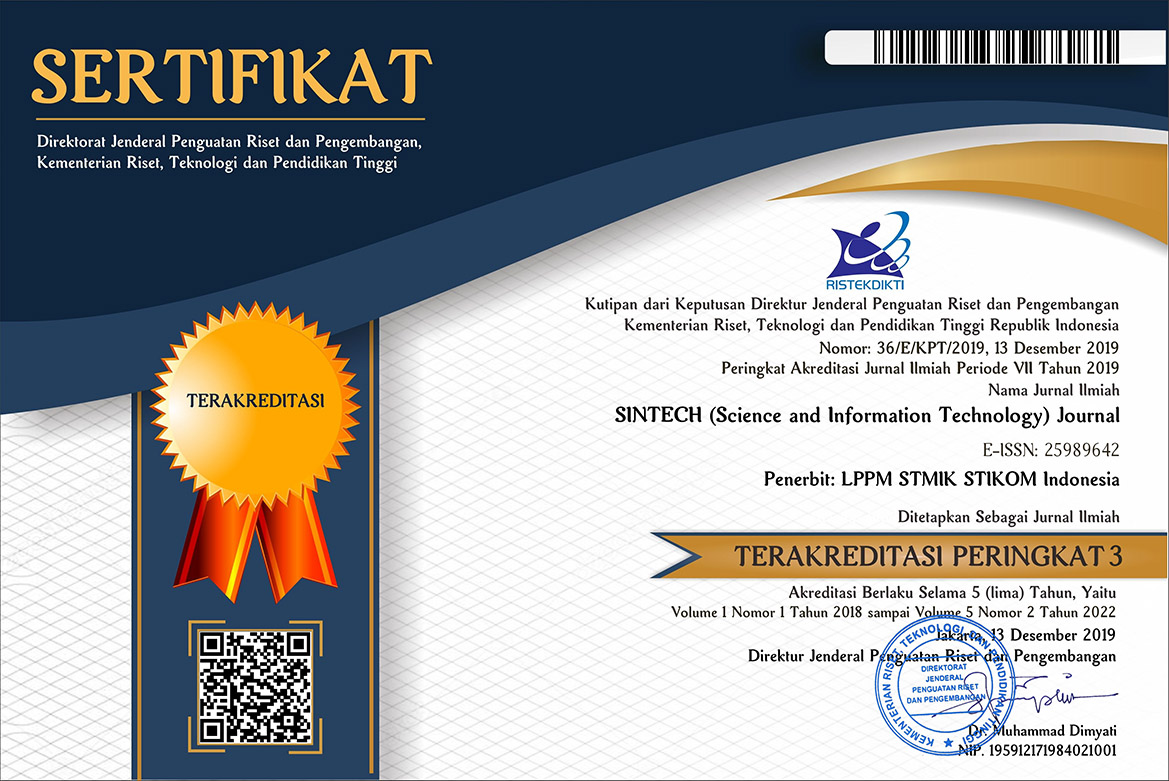A Graph Theory Approach for Spatial Data-Based Surface Water Flow Modeling
DOI:
https://doi.org/10.31598/sintechjournal.v7i1.1480Keywords:
Water flow modeling, D8 algorithm, graphAbstract
This research proposes an innovative approach that combines graph theory with spatial data to model surface water flow with the Single Flow Direction (SFD) concept, also known as the D8 algorithm. The objective is to show the water flow from the ground surface to a lower place. The research methodology involves collecting spatial data from the Digital Elevation Model (DEMNAS) in raster data type format. Test results show that the effectiveness of the graph approach in modeling water flow can produce clear flow output. This happens because each pixel traversed by water is connected by a line that forms a well-defined water flow path. This study significantly stimulates the development of more sophisticated modeling tools and practical applications in the future. This can help in more efficient management of water resources or produce more accurate flow modeling, contributing to improved understanding and better management of the environment.
Downloads
References
D. M. Wolock and G. J. McCabe, “Comparison of Single and Multiple Flow Direction Algorithms for Computing Topographic Parameters in TOPMODEL,” Water Resour. Res., vol. 31, no. 5, pp. 1315–1324, 1995, doi: 10.1029/95WR00471.
U. C. Nkwunonwo, M. Whitworth, and B. Baily, “A review of the current status of flood modelling for urban flood risk management in the developing countries,” Sci. African, vol. 7, p. e00269, 2020, doi: 10.1016/j.sciaf.2020.e00269.
W. W. Seemuller, “The extraction of ordered vector drainage networks from elevation data,” Comput. Vision, Graph. Image Process., vol. 47, no. 1, pp. 45–58, 1989, doi: 10.1016/0734-189X(89)90053-4.
N. Halal, M. F. Rustan, S. Cokrowibowo, N. Nur, and W. Firgiawan, “Penyelesaian Masalah Max Area of Island Menggunakan Connected 8 - Directionally,” vol. 1, pp. 274–278, 2022.
A. A. Ezzat, S. Liu, D. S. Hochbaum, and Y. Ding, “A Graph-Theoretic Approach for Spatial Filtering and Its Impact on Mixed-Type Spatial Pattern Recognition in Wafer Bin Maps,” IEEE Trans. Semicond. Manuf., vol. 34, no. 2, pp. 194–206, 2021, doi: 10.1109/TSM.2021.3062943.
P. A. Hawkins, “Spatial Relational Reasoning using Graph Neural Networks Search Strategies,” 2022.
W. Firgiawan, “USULAN ALGORITMA D32 UNTUK PEMODELAN ALIRAN AIR PERMUKAAN,” J. Eng. Res., 2023.
N. L. W. S. R Ginantra, M. A. Hanafiah, A. Wanto, R. Winanjaya, and H. Okprana, “Utilization of the Batch Training Method for Predicting Natural Disasters and Their Impacts,” IOP Conf. Ser. Mater. Sci. Eng., vol. 1071, no. 1, p. 012022, 2021, doi: 10.1088/1757-899x/1071/1/012022.
W. M. H.W. Ab Karim and M. G Hashim, “New Dl6 algorithm for surface water flow direction”, Jurnal Teknologi, vol. 71, no. 4, pp. 93-107, 2014.
S. Robinson and P. Macmillan, “The Practice of Model Development and Use Second edition,” p. 277, 2014.
T. Hendrawati et al., “Penerapan Deep Learning Dalam Pengenalan Endek Bali Menggunakan Convolutional Neural Network,” vol. 7, pp. 2118–2127, 2023, doi: 10.30865/mib.v7i4.6721.
W. Firgiawan, Z. Zainuddin, and A. Achmad, “Computation Time Analysis of D16 Algorithm for Surface Water Flow Direction Using Decision Tree.” 2022. [Online]. Available: https://ieeexplore.ieee.org/abstract/document/10057854/
A. J. Comber, C. F. Brunsdon, and C. J. Q. Farmer, “Community detection in spatial networks: Inferring land use from a planar graph of land cover objects,” Int. J. Appl. Earth Obs. Geoinf., vol. 18, no. 1, pp. 274–282, 2012, doi: 10.1016/j.jag.2012.01.020.
H. Nirwana, A. Afrisal, U. Maulidia, and F. Teknik, “Implementasi Algoritma D8 untuk Pencarian Titik Terendah pada Digital Elevation Model Nasional (DEMNAS),” pp. 269–273, 2022, [Online]. Available: https://tanahair.indonesia.go.id/demnas/.
D. Zhu and Y. Liu, “Modelling spatial patterns using graph convolutional networks,” Leibniz Int. Proc. Informatics, LIPIcs, vol. 114, no. 73, pp. 1–7, 2018, doi: 10.4230/LIPIcs.GIScience.2018.73.
N. L. W. S. R. Ginantra et al., Machine Learning- Teori dan Metode. 2023.
T. Hariyanto and R. Anindito, “Optimalisasi Penyediaan Data Spasial Resolusi Tinggi Dengan Pembangunan Image Map Service (Studi Kasus: Pertambangan Daerah Sumatera),” Geoid, vol. 14, no. 2, p. 61, 2019, doi: 10.12962/j24423998.v14i2.3907.
Badan Informasi Geospasial, “Seamless Digital Elevation Model (DEM) dan Batimetri Nasional.” 2018. [Online]. Available: https://tanahair.indonesia.go.id/demnas/#/
S. Bukhari, M. K. Jamil, M. Azeem, and S. Swaray, “Patched Network and Its Vertex-Edge Metric-Based Dimension,” IEEE Access, vol. 11, no. January, pp. 4478–4485, 2023, doi: 10.1109/ACCESS.2023.3235398.
A. A. G. B. Ariana, I. A. Wisky, N. L. W. S. R. Ginantra, M. R. Firmansyah, and G. S. A. Daengs, “Performance analysis of scaled conjugate gradient (SCG) algorithm on computing problems,” Int. Conf. Snikom 2021, vol. 2798, p. 020060, 2023, doi: 10.1063/5.0161430.
W. Firgiawan, Z. Zainuddin, and A. Ahmad, “Application of D8 Algorithm and Bernoulli Equation for Modeling Surface Water Flow Distribution.” 2022. [Online]. Available: https://ieeexplore.ieee.org/abstract/document/10330922.
Downloads
Published
How to Cite
Issue
Section
License
Copyright (c) 2024 Wawan Firgiawan, Hafsah Nirwana, Farid Wajidi, Zahir Zainuddin, Muh. Ahyar

This work is licensed under a Creative Commons Attribution-NonCommercial-ShareAlike 4.0 International License.
Copyright in each article belongs to the author.
- The authors admit that SINTECH Journal as a publisher who published the first time under
 Attribution-NonCommercial-ShareAlike 4.0 International (CC BY-NC-SA 4.0) License.
Attribution-NonCommercial-ShareAlike 4.0 International (CC BY-NC-SA 4.0) License. - Authors can include writing separately, regulate distribution of non-ekskulif of manuscripts that have been published in this journal into another version (eg sent to respository institution author, publication into a book, etc.), by recognizing that the manuscripts have been published for the first time in SINTECH Journal















1.png)




